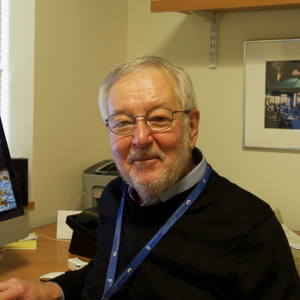Fat cells or adipocytes play a key role in the regulation of metabolism by insulin and other hormones. Obesity, too much fat, can lead to insulin resistance, diabetes and other pathologies due to failure of these cells to adequately store fat and its subsequent harmful spillover to other tissues. Surprisingly, a severe lack of fat in rare instances of genetic lipodystrophy causes similar problems. Moreover, there are “healthy obese” individuals who are able to accommodate an overabundance of fat without developing insulin resistance and diabetes. Our goals are to determine the mechanism(s) of fat cell dysfunction in both obesity/diabetes and lipodystrophy, which may eventually show the way to treatments and cures.
An interesting morphological feature of adipocytes is the unusually high number of plasma membrane micro-domains called caveolae, invaginations resembling little caves, which comprise 50% of their cell surface. We have engineered mice to lack a protein component of caveolae, cavin-1, called Polymerase 1 Transcription Releasing Factor (PTRF) which leads to a total loss of caveolae in in all tissues and results in profound insulin resistance and lipodystrophy (1,2), pathologies identical to those resulting from functional loss of cavin-1/PTRF in humans. The dysfunctional adipocytes in this condition result in large part from the absence of PTRF and subsequent inadequate ribosomal adaption such that the fat cells cannot respond to normal fasting and feeding cycles and lose protein mass and the ability to adequately store fat (3).
Adipose tissue is a robust endocrine organ that makes and secretes hormone-like proteins called adipokines, which have profound affects on insulin sensitivity (adiponectin) and energy balance (leptin) to name 2 examples. We have identified in the adipocyte endoplasmic reticulum (E.R.), adiporedoxin (Adrx), an oxidoreductase that is most highly expressed in fat cells. Adrx loss and over expression cause decreases and increases in the secretion of various proteins including adiponectin and collagens (4). Diminished collagen secretion in the Adrx null mouse reduces adipocyte fibrosis and would be expected to enhance fat cell adaptability. On the other hand, reduced adiponectin secretion should be deleterious to metabolic regulation. We are sorting out these details in mice and adipocyte cell lines.
Laboratory Members
Libin Liu – Instructor
Representative Publications
- Ding SY, Liu L, Pilch PF. Muscular dystrophy in PTFR/cavin-1 null mice. JCI Insight. 2017 Mar 09; 2(5):e91023.PMID: 28289716; DOI: 10.1172/jci.insight.91023;.
- Scheller EL, Doucette CR, Learman BS, Cawthorn WP, Khandaker S, Schell B, Wu B, Ding SY, Bredella MA, Fazeli PK, Khoury B, Jepsen KJ, Pilch PF, Klibanski A, Rosen CJ, MacDougald OA. Corrigendum: Region-specific variation in the properties of skeletal adipocytes reveals regulated and constitutive marrow adipose tissues. Nat Commun. 2016 Dec 08; 7:13775. PMID: 27929114;
- Liu L, Pilch PF. PTRF/Cavin-1 promotes efficient ribosomal RNA transcription in response to metabolic challenges. Elife. 2016 Aug 16; 5. PMID: 27528195. View in: PubMed
- Jedrychowski MP, Liu L, Laflamme CJ, Karastergiou K, Meshulam T, Ding SY, Wu Y, Lee MJ, Gygi SP, Fried SK, Pilch PF. Adiporedoxin, an upstream regulator of ER oxidative folding and protein secretion in adipocytes. Mol Metab. 2015 Nov; 4(11):758-70. PMID: 26629401. View in: PubMed
- Lo HP, Nixon SJ, Hall TE, Cowling BS, Ferguson C, Morgan GP, Schieber NL, Fernandez-Rojo MA, Bastiani M, Floetenmeyer M, Martel N, Laporte J, Pilch PF, Parton RG. The caveolin-cavin system plays a conserved and critical role in mechanoprotection of skeletal muscle. J Cell Biol. 2015 Aug 31; 210(5):833-49. PMID: 26323694. View in: PubMed
- Scheller EL, Doucette CR, Learman BS, Cawthorn WP, Khandaker S, Schell B, Wu B, Ding SY, Bredella MA, Fazeli PK, Khoury B, Jepsen KJ, Pilch PF, Klibanski A, Rosen CJ, MacDougald OA. Region-specific variation in the properties of skeletal adipocytes reveals regulated and constitutive marrow adipose tissues. Nat Commun. 2015; 6:7808. PMID: 26245716. View in: PubMed
- Liu L, Hansen CG, Honeyman BJ, Nichols BJ, Pilch PF. Cavin-3 knockout mice show that cavin-3 is not essential for caveolae formation, for maintenance of body composition, or for glucose tolerance. PLoS One. 2014; 9(7):e102935. PMID: 25036884. View in: PubMed
- Ding SY, Lee MJ, Summer R, Liu L, Fried SK, Pilch PF. Pleiotropic effects of cavin-1 deficiency on lipid metabolism. J Biol Chem. 2014 Mar 21; 289(12):8473-83. PMID: 24509860. View in: PubMed
- Fernández-Rojo MA, Gongora M, Fitzsimmons RL, Martel N, Martin SD, Nixon SJ, Brooks AJ, Ikonomopoulou MP, Martin S, Lo HP, Myers SA, Restall C, Ferguson C, Pilch PF, McGee SL, Anderson RL, Waters MJ, Hancock JF, Grimmond SM, Muscat GE, Parton RG. Caveolin-1 is necessary for hepatic oxidative lipid metabolism: evidence for crosstalk between caveolin-1 and bile acid signaling. Cell Rep. 2013 Jul 25; 4(2):238-47. PMID: 23850288. View in: PubMed
- Govender P, Romero F, Shah D, Paez J, Ding SY, Liu L, Gower A, Baez E, Aly SS, Pilch P, Summer R. Cavin1; a regulator of lung function and macrophage phenotype. PLoS One. 2013; 8(4):e62045. PMID: 23634221. View in: PubMed
Complete list can be found at BU Profiles
